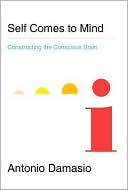Self Comes to Mind: Constructing the Conscious Brain
Search in google:
"From one of the most significant neuroscientists at work today, a pathbreaking investigation of a question that has confounded philosophers, psychologists, and neuroscientists for centuries: how is consciousness created?" "Antonio Damasio has spent the past thirty years studying and writing about how the brain operates, and his work has garnered acclaim for its singular melding of the scientific and the humanistic. In Self Comes to Mind, he goes against the long-standing idea that consciousness is somehow separate from the body, presenting compelling new scientific evidence that consciousness---what we think of as a mind with a self---is to begin with a biological process created by a living organism. Besides the three traditional perspectives used to study the mind (the introspective, the behavioral, and the neurological), Damasio introduces an evolutionary perspective that entails a radical change in the way the history of conscious minds is viewed and told. He also advances a radical hypothesis regarding the origins and varieties of feelings, which is central to his framework for the biological construction of consciousness: feelings are grounded in a near fusion of body and brain networks, and first emerge from the historically old and humble brain stem rather than from the modern cerebral cortex." Damasio suggests that the brain's development of a human self becomes a challenge to nature's indifference and opens the way for the appearance of culture, a radical break in the course of evolution and the source of a new level of life regulation---sociocultural homeostasis. He leaves no doubt that the blueprint for the work-in-progress he calls sociocultural homeostasis is the genetically well-established basic homeostasis, the curator of value that has been present in simple life-forms for billions of years. Self Comes to Mind is a groundbreaking journey into the neurobiological foundations of mind and self. The Barnes & Noble Review Antonio Damasio has a remarkable scientific imagination and an admirable literary style. The combination makes for fascinating reading. From the clinical data and the neuropsychological experimental work that has gathered both pace and precision in recent years, he draws compelling insights, forming a map of possibilities about the nature of that ultimate mystery, consciousness. He writes with such flair and confidence that it is almost as if he makes the mystery dissolve into knowledge before our eyes.
PART I STARTING OVER1 Awakening 3Goals and ReasonsApproaching the ProblemThe Self as WitnessOvercoming a Misleading IntuitionAn Integrated PerspectiveThe FrameworkA Preview of Main IdeasLife and the Conscious Mind2 From Life Regulation to Biological Value 31The Implausibility of RealityNatural WillStaying AliveThe Origins of HomeostasisCells, Multicellular Organisms, and Engineered MachinesBiological ValueBiological Value in Whole OrganismsThe Success of Our Early ForerunnersDeveloping IncentivesConnecting Homeostasis, Value, and ConsciousnessPART II WHAT'S IN A BRAIN THAT A MIND CAN BE?3 Making Maps and Making Images 63Maps and ImagesCutting Below the SurfaceMaps and MindsThe Neurology of MindThe Beginnings of MindCloser to the Making of Mind?4 The Body in Mind 89The Topic of the MindBody MappingFrom Body to BrainRepresenting Quantities and Constructing QualitiesPrimordial FeelingsMapping Body States and Simulating Body StatesThe Source of an IdeaThe Body-Minded Brain5 Emotions and Feelings 108Situating Emotion and FeelingDefining Emotion and FeelingTriggering and Executing EmotionsThe Strange Case of William JamesFeelings of EmotionHow Do We Feel an Emotion?The Timing of Emotions and FeelingsThe Varieties of EmotionUp and Down the Emotional RangeAn Aside on Admiration and Compassion6 An Architecture for Memory 130Somehow, SomewhereThe Nature of Memory RecordsDispositions Came First, Maps FollowedMemory at WorkA Brief Aside on Kinds of MemoryA Possible Solution to the ProblemMore on Convergence-Divergence ZonesThe Model at WorkThe How and Where of Perception and RecallPART III BEING CONSCIOUS7 Consciousness Observed 157Defining ConsciousnessBreaking Consciousness ApartRemoving the Self and Keeping a MindCompleting a Working DefinitionKinds of ConsciousnessHuman and Nonhuman ConsciousnessWhat Consciousness is NotThe Freudian Unconscious8 Building a Conscious Mind 180A Working HypothesisApproaching the Conscious BrainPreviewing the Conscious MindThe Ingredients of a Conscious MindThe ProtoselfConstructing the Core SelfThe Core Self StateTouring the Brain as It Constructs a Conscious Mind9 The Autobiographical Self 210Memory Made ConsciousConstructing the Autobiographical SelfThe Issue of CoordinationThe CoordinatorsA Possible Role for the Posteromedial CorticesThe PMCs at WorkOther Considerations on the Posteromedial CorticesA Closing Note on the Pathologies of Consciousness10 Putting It Together 241By Way of SummaryThe Neurology of ConsciousnessThe Anatomical Bottleneck Behind the Conscious MindFrom the Ensemble Work of Large Anatomical Divisions to the Work of NeuronsWhen We Feel Our PerceptionsQualia IQualia IIQualia and SelfUnfinished BusinessPART IV LONG AFTER CONSCIOUSNESS11 Living with Consciousness 267Why Consciousness PrevailedSelf and the Issue of ControlAn Aside on the UnconsciousA Note on the Genomic UnconsciousThe Feeling of Conscious WillEducating the Cognitive UnconsciousBrain and JusticeNature and CultureSelf Comes to MindThe Consequences of a Reflective SelfAppendix 299Notes 319Acknowledgments 343Index 345








